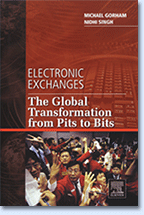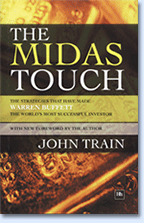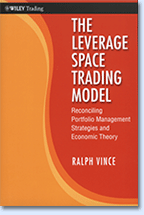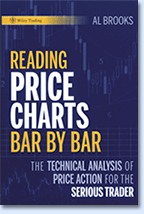Books For Traders
November 2009
- Electronic Exchanges: The Global Transformation From Pits To Bits
- Financial Instruments: Equities, Debt, Derivatives, And Alternative Investments
- The Midas Touch: The Strategies That Have Made Warren Buffett The Worldís Most Successful Investor
- The Leverage Space Trading Model: Reconciling Portfolio Management Strategies and Economic Theory
- Reading Price Charts Bar By Bar: The Technical Analysis Of Price Action For The Serious Trader
- The Truth About Day Trading Stocks: A Cautionary Tale About Hard Challenges, And What It Takes To Succeed
Return to Contents

![]() Electronic Exchanges: The Global
Transformation From Pits To Bits
Electronic Exchanges: The Global
Transformation From Pits To Bits
(338 pages, £29.99 hardcover, 2009, ISBN
978-0-12-374252-0) by Michael Gorham
& Nidhi Singh, published by
Elsevier.
The financial exchanges are undergoing tremendous transformations. This book chronicles the shifts that have occurred in the financial exchanges and analyzes them to identify the drivers behind this phenomenon. It identifies implications arising out of these changes and explores key trends, including the integration of markets from all over the world onto a single screen, the rise of modular exchange, and the outsourcing of exchange functions. The old ways are being destroyed. New jobs and ways of working with exchanges are being created. This book helps evaluate exchanges in a new light.
ADDITIONAL INFORMATION: www.Elsevier.com
BACK TO LIST

![]() Financial Instruments: Equities, Debt,
Derivatives, And Alternative Investments
Financial Instruments: Equities, Debt,
Derivatives, And Alternative Investments
(366 pages, $65 hardcover, 2009, ISBN
978-1-59184-227-9) by David M.
Weiss, published by Portfolio of the
Penguin Group.
It is important for financial professionals to understand the array of instruments being traded in the world’s financial markets. This guide is written as a tool for the brokers, portfolio managers, financial planners, and institutional investors. It outlines the tools available and their functions. Each product’s full story is given, along with an explanation of the instruments, terms, uses, and misunderstandings. In addition to the basic instruments, the many types of related products, including the exotic ones, are explored. This is a definitive resource for sophisticated investors.
ADDITIONAL INFORMATION: www.Penguin.com
BACK TO LIST

![]() The Midas Touch: The Strategies That
Have Made Warren Buffett The World’s Most
Successful Investor
The Midas Touch: The Strategies That
Have Made Warren Buffett The World’s Most
Successful Investor
(243 pages,
£14.00 hardcover, 2009, ISBN
978-1906659189) by John Train,
published by Harriman House Ltd.
In the first 13 years of Warren Buffett’s investing partnership, if you had placed your $10,000 into his hands, it would have become $239,738. If you had left your money in his care in the Berkshire-Hathaway corporation formed from the original partnership, by 1986 the original $10,000 would have become well over $5 million. This 2009 reprint of John Train’s 1987 book attempts to explain how Buffett achieved his success. It is written with style and wit, and it is a testimony to its worthy subject.
ADDITIONAL INFORMATION: www.Harriman-House.com
BACK TO LIST

![]() The Leverage Space Trading Model:
Reconciling Portfolio Management Strategies and
Economic Theory
The Leverage Space Trading Model:
Reconciling Portfolio Management Strategies and
Economic Theory
(191 pages, $65
hardcover, 2009, ISBN 978-0-470-45595-1) by
Ralph Vince, published by John
Wiley & Sons.
The widely accepted approaches of combining assists into a portfolio and determining their relative quantities are incorrect and illuminate nothing aside from the illusion of safety through diversification, the author states. What is needed is a viable way to address the real-world dictates. This book departs from informed orthodoxy to present a new approach to portfolio management. For those who don’t want to do the math, this book is written in two channels, one with math, one without. This book will change how you think about money management and portfolio allocations.
ADDITIONAL INFORMATION: www.wiley.com
BACK TO LIST

![]() Reading Price Charts Bar By Bar: The
Technical Analysis Of Price Action For The
Serious Trader
Reading Price Charts Bar By Bar: The
Technical Analysis Of Price Action For The
Serious Trader
(402 pages, $75
hardcover, 2009, ISBN 978-0-470-44395-8) by
Al Brooks, published by John
Wiley & Sons.
Understanding price action is all you really need to succeed in this arena. It allows you to focus on the process without being overwhelmed by a complicated collection of trading techniques. It can significantly enhance returns and minimize downside risk. Chart patterns are one way to apply price action to your analysis. Author Brooks discovered that reading charts without indicators was simple and profitable. Anyone can look at a chart at the end of the day and clearly see the best entry and exit points. But doing that in real time is much more difficult. If you learn to read price charts, find reliable patterns, and get a feel for the market and time frame for your situation, you can make money.
ADDITIONAL INFORMATION: www.wiley.com
BACK TO LIST

![]() The Truth About Day Trading Stocks: A
Cautionary Tale About Hard Challenges, And What
It Takes To Succeed
The Truth About Day Trading Stocks: A
Cautionary Tale About Hard Challenges, And What
It Takes To Succeed
(188 pages,
$60 hardcover, 2009, ISBN 978-0-470-44848-9) by
Josh DiPietro, published by John
Wiley & Sons.
Daytrading is a high-risk profession. No one should contemplate daytrading without giving thought to all the ways they could lose, and all the ways they could lessen or avoid losses. Yet many people enter the game with unrealistic expectations. Seminars and software alone don’t make a successful daytrader. A trader must learn the hard lessons of self-discipline and many other things to have a real chance of success. This book is written with a sometimes humorous tone and attempts to slow down the dangerous fervor of the average amateur, and then demonstrate the ways you can become a professional and not lose your shirt in the process. You must know yourself, understand the risk, and remember that your skill level is a gradually changing, ongoing process. There is always more to learn.
ADDITIONAL INFORMATION: www.wiley.com
BACK TO LIST